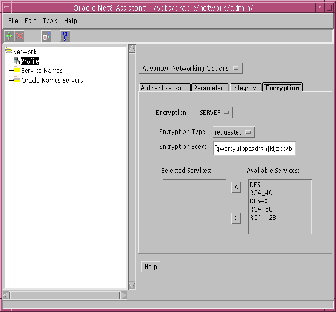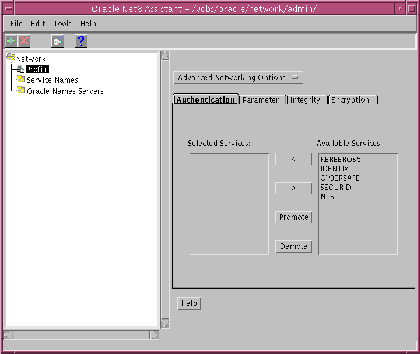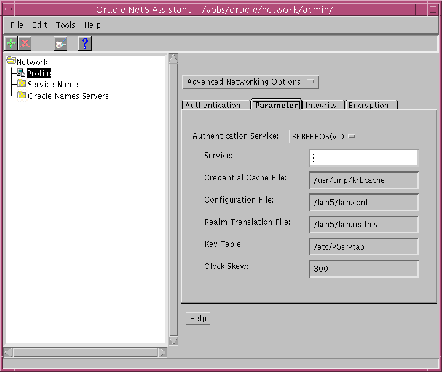Release 8.0
A58229-01
Library |
Product |
Contents |
Index |
| Oracle Advanced Networking Option Administrator's Guide Release 8.0 A58229-01 |
|
This chapter describes how to configure and use the SecurID authentication adapter with the Oracle server and clients. It assumes that you are familiar with the Security Dynamics ACE/Server and that the ACE/Server is installed and running. Refer to the "Preface" for a list of related publications to read.
The following topics are discussed:
To use the SecurID authentication adapter included in the Oracle Advanced Networking Option release 8.0.3, you need the following:
The SecurID authentication adapter does not support database links, also known as "proxy authentication." This is a direct consequence of the fact that the SecurID card codes can only be used once.
When using the SecurID authentication adapter, password encryption is disabled. This means that the SecurID card code (and, if you use standard cards, the PIN), are sent over to the Oracle server in clear text. This could be a security problem, so Oracle recommends that you turn on the Oracle Advanced Networking Option datastream encryption, which ensures that the PIN is encrypted when sent to the Oracle server. For information on how to use datastream encryption, see Chapter 2, "Configuring Encryption and Checksumming".
This section contains information on the following tasks:
Register the machine on which the Oracle Server resides as a SecurID client with the ACE server. You can do this with the Security Dynamics tool sdadmin. From the Client menu, choose Create Client (ACE/Server 1.2.4) or Add Client (ACE/Server 2.0), to create a client.
Refer to the Security Dynamics ACE/Server Instruction manual, version 1.2.4, or to the Security Dynamics ACE/Server version 2.0 Administration manual for more detailed information.
First verify that the ACE/Server, the Oracle server, and the Oracle Advanced Networking Option are installed.
Make sure that the Oracle server can discover what the correct UDP port for contacting the ACE/Server is. These port numbers are typically stored in a file called services. On the UNIX operating system, this file is typically in the /etc directory. If you are using NIS (Network Information Services) as a naming service, make sure that the services map contains the correct entries for SecurID.
|
Note:
You can verify which port the ACE server is using by running the Security Dynamics tool |
Install the Oracle Advanced Networking Option on the Oracle server and Oracle client using the Oracle Installer.
You can obtain the SecurID configuration files from any other SecurID client or from the machine that runs the ACE/Server.
These files are typically stored in /var/ace. On the Oracle server machine, create this directory and copy the configuration files to it. At the minimum, you need the file sdconf.rec. The configuration files are used by both Oracle and the standard SecurID tools. Because the SecurID tools run setuid root, there can be a problem with the access permissions on the directory /var/ace and the files in this directory. Make sure that the owner of the Oracle executable (for example, the user "oracle8") is able to read all the files in /var/ace and can create new files in this directory.
|
Attention: Do not attempt to overcome this by running Oracle setuid root. It is not necessary, and it is dangerous to do so. |
There are two ways to reach this goal without compromising security. Both ways work, but it is recommended that you use method #1. Both methods allow you to use Oracle with the SecurID authentication adapter and still continue using the other SecurID tools.
The owner of the Oracle executable should also own the /var/ace directory and the files in /var/ace. For example, if the owner of the Oracle executable is the user "oracle8," perform the following steps, as root:
# chown oracle8 /var/ace # chmod 0770 /var/ace # chown oracle8 /var/ace/* # chmod 0660 /var/ace/*
The other option is to have root own the /var/ace directory and the files in /var/ace, but give the Oracle group read and write access. If the Oracle group is "dba", you need to perform the following steps, as root:
# chown root /var/ace # chmod 0770 /var/ace # chgrp dba /var/ace # chown root /var/ace/* # chmod 0660 /var/ace/* # chgrp dba /var/ace/*
The Oracle process will act as an ACE server client. For this reason, you need to install the ACE client software on the Oracle server machine. For information on how to install an ACE client, refer to the ACE/Server Version 2.0 Client for UNIX manual.
Note the following:
/var/ace directory. If you currently have the ACE configuration data in a different location, you should create a symbolic link using the following command:
# ln -s $VAR_ACE /var/ace
/var/ace (or $VAR_ACE if you use the symbolic link shown above).
Whether Oracle can read the configuration data depends on how you installed the ACE client software on the Oracle server. During the installation of the ACE client software, you can specify which administrator should own the configuration files.
|
Attention: Whether you use Method 1 or Method 2, below, make sure that you do not install Oracle as root. |
If root is the owner of the ACE server configuration data files, you will have to change the UNIX file permissions so that the owner of the oracle executable can read and write to these files. For example, the following commands give Oracle access to the files, and all the Security Dynamics tools that run as setuid root will still be able to access the files.
# chown oracle8 /var/ace # chown oracle8 /var/ace/* # chmod 0770 /var/ace # chmod 0660 /var/ace/*
If the environment variable VAR_ACE is set to a different location than /var/ace, you should instead execute the following commands:
# ln -s $VAR_ACE /var/ace # chown oracle8 $VAR_ACE # chown oracle8 $VAR_ACE/* # chmod 0770 $VAR_ACE # chmod 0660 $VAR_ACE/*
If the ACE files are not owned by root, you have two options:
For the change to take effect, do the following:
The following steps show you how to use the Net8 Assistant to configure the
SECURID authentication adapter. Refer also to the Net8 Assistant online HELP
system for instructions on how to configure the SECURID Authentication adapter.
Configure Clients, and Servers, to use encryption as follows. Refer to Figure 5-1, "Oracle Net8 Assistant Profile Encryption Tab".

Next, you must configure an authentication service on your network. Refer to Figure 5-2, "Oracle Net8 Assistant Profile Authentication Tab".

You now must configure the authentication parameters. Refer to Figure 5-3, "Oracle Net8 Assistant Profile Parameter Tab". You do not provide any additional parameter for the SECURID authentication service.

To create users for the SecurID authentication adapter, perform the following steps:
If you want the user to be able to specify a new PIN to the card using the Oracle tools, choose the option that allows the user to make up his or her own PIN. If you do not allow this, the user will have to use the Security Dynamics tools to generate a PIN if the card is in new-PIN mode. Activate the user on the Oracle Server. (The Oracle Server should already be registered as a SecurID client.)
SVRMGRL> connect system/manager SVRMGRL> create user os_authent_prefix username identified externally
The OS_AUTHENT_PREFIX is an Oracle Server initialization parameter (for example, in INIT.ORA). The OS_AUTHENT_PREFIX default value is OPS$. The username should be the same as the name you assigned to the card in step 1 above.
Example: Assuming you have assigned a card to the user "king", and assuming that os_authent_prefix has been set to a null value (""), at this point you should create an Oracle user account using the following syntax:
SQLDBA> create user king identified externally;
SQLDBA> grant create session to king;
The user "king" can now connect to Oracle using his or her SecurID card.
For information on how to log into an Oracle server after the SecurID adapter has been installed and configured, see Section 6.1.1, "Log into the Oracle Server".
This section lists some things to verify if you experience problems while configuring the SecurID Adapter.
Use the SecurID tool kitconts (for ACE/Server 1.2.4) or sdinfo (for ACE/Server 2.0) to verify the name of the authentication service and the port numbers that SecurID is expecting to use. Verify that these port numbers match those in
/etc/services, or the services map if you are using NIS.
(Applies to ACE/Server release 1.2.4 only) Verify that the /var/ace/sdconf.rec file is present on the machine running the Oracle server. Also verify that the permissions on the /var/ace/sdconf.rec file and the directory /var/ace are set so that the Oracle process can read and write in the directory.
(Applies to ACE/Server release 2.0 only) Make sure the ACE configuration data is in the /var/ace directory. Use of the VAR_ACE environment variable is not supported. Also make sure that the owner of the oracle executable can read and write the files in this directory.
trace_level_server = admin
Turning tracing on at the client side is less informative, because all interaction between the Oracle server and the ACE server happens at the Oracle server side of the SQL*Net connection. Be sure to turn off tracing when you have completed your check.
SQL> select * from all_users;
to get a list of all database users.
sqlplus system/manager@oracle_dbname
the SecurID log file displays:
03/24/95 10:04 User not on client machinename
This is not an error. Since the Oracle client and server negotiated to use SecurID because of the SQLNET.AUTHENTICATION_SERVICES line in SQLNET.ORA, Oracle will contact the ACE/Server to validate 'system'. When validation fails, Oracle will validate the password internally. If the password is valid, you will be able to connect.
The only way to eliminate the warning message is to disable the SecurID authentication adapter. To do so, change the SQLNET.ORA file on the Oracle client to:
SQLNET.AUTHENTICATION_SERVICES=(NONE)
Setting this parameter to this value disables the SecurID authentication adapter. You will no longer be able to connect to Oracle using the SecurID card.
This section describes how to use the Oracle SecurID authentication adapter with the Oracle client tools. This chapter assumes that you are already familiar with SecurID concepts, and that you have configured Oracle for use with the SecurID adapter. (See Section 5.4, "Configure the SecurID Authentication Adapter using the Net8 Assistant" for information.) Also refer to the "Preface" of this guide for a list of publications to read.
Before you can use the SecurID authentication adapter to verify passwords, make sure the following things have been done:
The SecurID authentication adapter allows you to log into the Oracle server with the PASSCODE that is generated by the SecurID card. The PASSCODE replaces the password in the Oracle connect statement.
There are two types of SecurID cards:
Depending on the type of card, you type the PIN
or
The standard cards generate and display a PASSCODE. When logging in to Oracle, you need to specify your username, your PIN and the current PASSCODE, using the following syntax:
SQL>connect <username>/<pin><passcode>@<service_name>
For example, if the card is assigned to user king, the PIN is "3511," and the card shows the number "698244," this is how you would log into Oracle using SQL*Plus:
% sqlplus king/3511698244@oracle_databaseor,
% sqlplus king@oracle_database % password: 698244
If you have a PINPAD card, you first have to type in your PIN on the card and generate a new PASSCODE. You would then use this PASSCODE to connect to Oracle using the following syntax:
SQL>connect <username>/<passcode>@<service_name>
For example, if the card is assigned to user "king", first generate a PASSCODE by typing the PIN on the PINPAD card. (Refer to the Security Dynamics documentation on how to do this.) For example, if the generated PASSCODE is "698244", to connect to Oracle using SQL*Plus, you would type:
% sqlplus king/698244@oracle_dbname
If you are logging in for the first time, or the administrator has put your card in the new-PIN mode, you have to assign a PIN to the card. You can tell that this is the case if, while trying to connect to Oracle, you get the following error message:
ORA-12681 "Login failed: the SecurID card does not have a pincode yet"
Assigning a PIN to a card is easy and can be done by connecting to the Oracle Server using a special syntax. First, you need to select a PIN, which is typically 4 to 8 digits long. Depending on the type of SecurID card you have, you may be able to use letters too.
The syntax while connecting to the Oracle database is:
SQL>connect <username>/"+<pincode>+<passcode>"@oracle_dbname SQL>connect
For the passcode, enter the cardcode that is currently displayed on your SecurID card's LCD. If you have a PINPAD card, do not enter the PIN on the card.
For example, if the card is assigned to user "king", your new PIN is "45618", and the SecurID card currently displays number "564728", you would type:
% sqlplus king/"+45618+564728"@oracle_dbname % passwd:<passcode>
If the new PIN is accepted, you will be connected to Oracle. The next time you want to connect to Oracle you should use the procedure described in "Logging into the Oracle Server". If the new PIN is rejected, you will get the following error:
ORA-12688 "Login failed: the SecurID server rejected the new pincode"
Following are some possible reasons why a PIN would be rejected:
As an additional safety step, the ACE/Server sometimes asks for the next card code, to ensure that the person who is trying to log in actually has the card in his or her possession. This is the case if you get the following error message when you try to log into Oracle:
ORA-12682, "Login failed: the SecurID card is in next PRN mode"
The next time you want to log in to Oracle, you will have to specify the next two card codes. The syntax you use to log into Oracle depends on the kind of SecurID card you have (Standard versus PINPAD).
If you have a standard card, specify the following:
Steps 1, 2, and 3 above replace the password. The "+" character is important, because it separates the first card code (passcode) from the second one. Use the following syntax:
SQL>connect <username>/ "<pincode><passcode>+<next passcode>"@<service_name>
For example, if the card is assigned to user "king", the PIN is "3511", and the card first shows the number "698244" and the next number is "563866", you would type:
% sqlplus king/"3511698244+563866"@oracle_database
This connects you to the Oracle server and puts the card back into normal mode. The next time you want to log in to the Oracle server, use the procedure described in Section 5.8.1, "Log into the Oracle Server".
If you have a PINPAD card, do the following to log on to the Oracle server:
SQL>connect <username>/ "<first passcode>+<second passcode>"@service_name
For example, if the card is assigned to user "king":
% sqlplus king/"231003+831234"@oracle_dbname
This connects you to Oracle and puts the card back into normal mode. The next time you want to log in to Oracle, use the procedure described in Section 5.8.1, "Log into the Oracle Server".